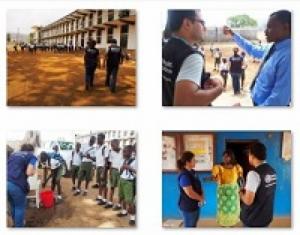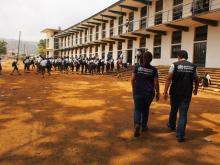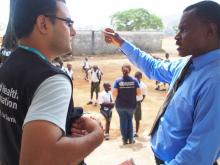Photo story: Sierra Leone students back to healthier schools with WHO support
Tuesday was a happy day in SierraLeone as children returned to school after many months away due to the Ebola outbreak. Read how the Government of Sierra Leone, WHO and partners made that possible
Tuesday was a happy day in SierraLeone as children returned to school after many months away. The Ministry of Education and the Ministry of Health and Sanitation of Sierra Leone, WHO, UNICEF and other partners worked together to plan the reopening.About 40 schools had been used to respond to Ebola as treatment or holding centres, for example. WHO’s infection prevention and control experts trained and supervised the teams who disinfected these schools.
The Prince of Wales Secondary School in Freetown, SierraLeone was closed on 14 July 2014. On Tuesday over 1000 students came back to study. Acting principal Rodney Coker said he needed help repairing toilet facilities, and would appreciate more garbage bins. He thanked WHO for its support. "We are listening to you and we are getting to where we need to be: normalcy."
Students in SierraLeone use newly installed hand washing stations, which all schools must have from now on. Hand washing is an important measure to maintain health at all times. Across the country, one teacher from every school attended a 7-day workshop on health and safety. They will be their respective school’s focal points to enforce measures such as asking sick students to stay at home, fever checks at the entry point of schools, and regular hand washing, to keep students and teachers healthy.
The Methodist Boys High School in Kissy, Freetown, SierraLeone was not yet ready to receive students on Tuesday. WHO infection control specialists Natalia Ribeiro and Alaa Gad met with principal Emma Dupigny who was initially skeptical of the cleanliness of the surroundings. She was reassured by the team's explanation of the Ebola virus' lifespan, and in hearing the details of what had been done to disinfect any contaminated areas. Offices and school rooms had been used as office and storage space only, while the Médecins Sans Frontières-run treatment unit itself was housed in tents to the rear of the school.







